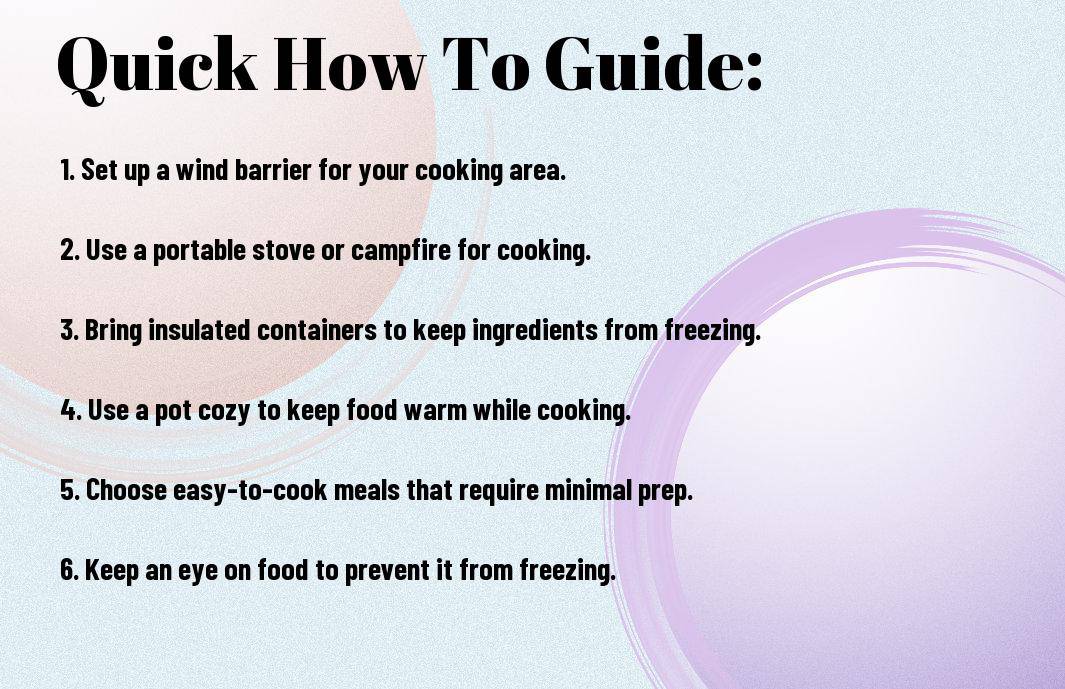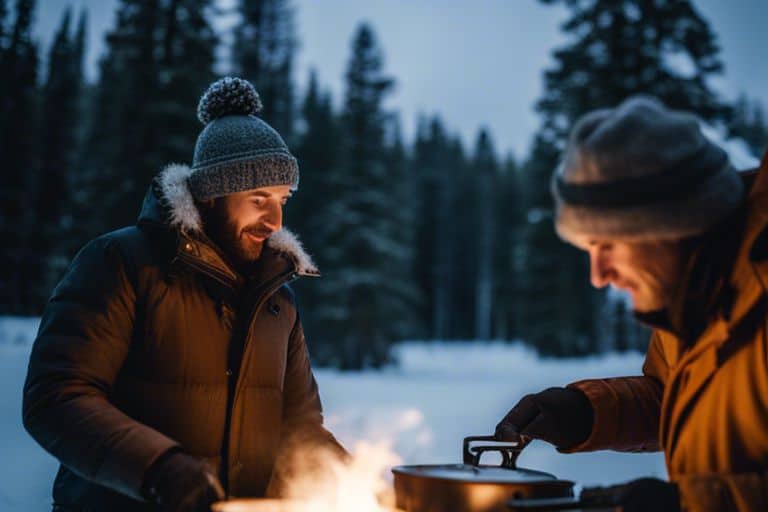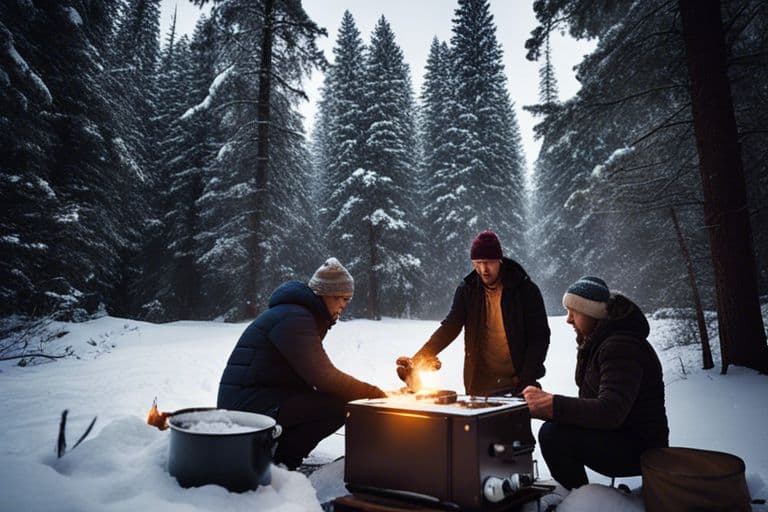Embarking on a winter camping trip can be an exhilarating experience, but navigating icy conditions and preparing food can pose significant challenges. Fortunately, with the right knowledge and preparation, you can ensure that you stay well-fed and safe during your winter adventure. In this guide, you will learn essential tips and techniques for cooking and preparing food in dangerous icy conditions, allowing you to enjoy delicious meals and stay nourished throughout your winter camping expedition.
First and foremost, it is crucial to understand the potential risks and dangerous associated with preparing food in icy conditions. The extreme cold can make it difficult to light a fire or use a camp stove, and the risk of hypothermia or frostbite is always a concern. Additionally, finding suitable ingredients and ensuring proper food storage can be challenging. However, by following the tips and techniques outlined in this guide, you can confidently navigate these challenges and prepare hot, satisfying meals to fuel your winter adventure.
Key Takeaways:
- Plan ahead: Before your winter camping trip, carefully plan your meals and ensure you have the necessary ingredients and equipment for cooking in icy conditions.
- Use a camp stove: A reliable camp stove is essential for cooking in icy conditions, as it provides a consistent source of heat that can withstand the cold temperatures.
- Protect your food: Store your food in insulated containers or bear-proof canisters to protect it from freezing temperatures and wildlife.
- Keep it simple: Stick to straightforward recipes that require minimal cooking time and effort, as well as simple ingredients that are easy to prepare in cold conditions.
- Stay safe: Practice proper food safety measures, such as keeping perishable items cold and ensuring meats are thoroughly cooked, to prevent foodborne illness during winter camping trips.

Preparing for Your Winter Camping Trip
Some preparation is necessary for a successful winter camping trip. The icy conditions pose unique challenges that must be addressed in advance. By understanding how to dress for success, ensuring you have the essential equipment and packing tips, and selecting appropriate foods for cold weather, you can set yourself up for a safe and enjoyable experience in the winter wilderness.
Understanding How to Dress for Success
When it comes to dressing for winter camping, layering is key. You want to have a base layer that wicks moisture away from your body, an insulating middle layer, and an outer layer that protects you from the elements. It’s also important to avoid cotton clothes as they retain moisture which can lead to cold and damp conditions. Instead, opt for wool or synthetic materials that will keep you warm even if they get wet. Don’t forget to protect your extremities with insulated gloves, hats, and waterproof boots.
Essential Equipment and Packing Tips
When it comes to packing for a winter camping trip, it’s important to be meticulous in your planning. Make sure to pack a four-season tent that can withstand heavy snow and strong winds. Additionally, a sleeping bag with a temperature rating suitable for the expected conditions is essential. Other important items to pack include a stove and fuel, insulated water bottles, emergency supplies such as a first-aid kit and fire-starting materials, and appropriate navigation tools. Knowing how to pack efficiently and keep your clothing and gear dry is also crucial for a successful winter camping trip.
Selecting Appropriate Foods for Cold Weather
When selecting foods for winter camping, it’s important to prioritize nutrition and energy. Opt for high-calorie, lightweight foods that will keep you fueled and warm, such as nuts, dried fruits, and energy bars. Pack foods that can be easily prepared in cold conditions, such as instant soups, oatmeal, and dehydrated meals. Additionally, don’t forget to bring along hot beverages like tea or coffee to warm you from the inside out. Keeping your body fueled with the right foods is essential for staying warm and maintaining energy in cold weather.
Setting Up Your Winter Camp Kitchen
After a long day of winter camping, having a well-organized and efficient camp kitchen is crucial for keeping you warm, well-fed, and in good spirits. In order to make the most of your winter camping food preparation, it’s important to set up your camp kitchen in a way that will protect you from the elements and allow you to cook and prepare food safely and comfortably.
Choosing a Safe and Sheltered Location
When setting up your winter camp kitchen, the first step is to find a safe and sheltered location. Look for an area that is protected from strong winds and potential snow drifts. Avoid setting up your kitchen near dead or weak trees that may pose a threat of falling branches, and be sure to stay clear of avalanche-prone slopes. Your chosen location should also be in close proximity to your campsite, to minimize the distance you have to travel in cold and potentially treacherous conditions.
It’s also important to consider the positioning of your kitchen in relation to the sun, as well as any nearby natural windbreaks such as rock formations or dense trees. By carefully selecting your location, you can minimize the risk of exposure to harsh winds and other dangerous conditions, while also maximizing the efficiency and comfort of your food preparation process.
Constructing Wind Barriers and Insulation Methods
Once you’ve selected a suitable location, it’s time to construct wind barriers and insulation methods to further protect your winter camp kitchen. Creating a solid barrier against the wind will not only make your cooking experience more enjoyable, but it will also allow you to conserve fuel and cook your food more efficiently.
One effective method for creating wind barriers is to use a combination of tarps, snow walls, or natural features such as rock formations to shield your cooking area from the wind. You may also want to consider setting up your kitchen in a snow pit or digging a trench around your cooking area to create additional protection from gusts of wind.
By building effective wind barriers and insulation methods, you can significantly improve the safety and comfort of your winter camp kitchen, ensuring that you are able to cook and prepare food with ease even in the most challenging conditions.
Techniques for Food Storage in Cold Environments
Despite the challenges of storing food in icy conditions, proper techniques can help you keep your provisions safe and edible during winter camping. It’s crucial to understand how to prevent food from freezing and take wildlife precautions for responsible and ethical storage.
Preventing Food from Freezing
When camping in frigid temperatures, it’s essential to prevent your food from freezing, as this can alter its texture and taste. To keep your food from freezing, you can pack it in insulated containers or wrap it in additional layers of material, such as blankets or clothing, before placing it in your backpack or campsite. Additionally, placing your food in the center of your backpack, away from the cold air, can help maintain its temperature and prevent freezing.
Wildlife Precautions and Storage Ethics
When camping in cold environments, it’s important to take wildlife precautions and practice proper storage ethics to avoid attracting animals to your campsite. You can achieve this by hanging your food in a bear-resistant bag from a tree branch, at least 10 feet off the ground and 4 feet from the trunk. This prevents animals from accessing your food and helps protect both you and the wildlife from potentially dangerous encounters. Additionally, avoid leaving food scraps or packaging around your campsite to maintain a responsible and ethical camping environment.
Safe Water Sourcing and Treatment
To ensure your safety during winter camping, you need to be mindful of where you source your water and how you treat it. In icy conditions, finding and treating water becomes more challenging but is essential for your well-being and survival.
Locating Water in a Frozen Landscape
First, you must locate a water source in a frozen landscape. Look for unfrozen streams, springs, or lakes. These sources can often be found in areas with less snow cover or where the water is flowing with more force, preventing it from freezing entirely. Remember to exercise caution when walking on ice and avoid areas with cracks or thin ice. Additionally, be aware of potentially hidden hazards under the snow, such as rocks or tree branches.
Methods of Melting Snow for Drinking
When water sources are scarce, melting snow becomes a survival necessity. However, consuming untreated melted snow can lead to illnesses due to potential contaminants. It is crucial to melt the snow properly and then treat it before drinking. You can melt snow by using a camp stove, melting it in a pot over a fire, or utilizing a solar still. Once you have melted the snow, you need to treat the water to make it safe for drinking. Boiling the water is the most effective method to kill harmful pathogens. If boiling is not an option, you can use water purification tablets or a portable water filter as alternative methods to ensure the safety of the water.
Mastering the Use of Cooking Appliances
Keep in mind that when it comes to cooking in icy conditions during winter camping, having the right cooking appliances is crucial. These can range from portable stoves to grills, but it’s important to know how to use them effectively in cold weather. For a detailed guide on how to do winter camp cooking right, you can check out How to Do Winter Camp Cooking Right.
Tips for Using Portable Stoves Safely
When using portable stoves in icy conditions, it’s essential to follow safety protocols to avoid accidents. Always make sure to set up your stove on a stable, level surface to prevent it from tipping over. Additionally, keep your stove away from any flammable materials, including tents, sleeping bags, and clothing. Remember to use long-handled utensils to cook and stir your food to reduce the risk of burns. Lastly, always have a fire extinguisher or a bucket of water nearby in case of an emergency.
After you have finished cooking, allow the stove to cool down completely before attempting to move or store it.
How to Manage Fuel Efficiency
During winter camping, managing fuel efficiency is crucial, as running out of fuel in icy conditions can be dangerous. To ensure you have enough fuel, pack extra canisters or bottles, and keep them from freezing by storing them in an insulated container. If temperatures are extreme, you may need to place the fuel canister in a warm water bath to keep it from freezing and maintain a sufficient flame. Additionally, consider using a windscreen to protect the flame from wind, which can help conserve fuel.
Remember, fuel efficiency is not just about having enough fuel—it’s also about using it wisely to avoid running into trouble during your cooking process.

Cold Weather Cooking Strategies
Unlike cooking in warm weather, winter camping requires different strategies to prepare food in icy conditions. The cold temperature and harsh environment can pose unique challenges for cooking and food preparation. It’s essential to be prepared and equipped with the right knowledge and skills to ensure a successful cooking experience during winter camping. In this chapter, you will learn about cold weather cooking strategies and techniques to help you create warm and satisfying meals in the snow.
Adjusting Recipes for High Altitude and Low Temperatures
When cooking in cold weather, especially at high altitudes, you need to make adjustments to your recipes to account for the lower boiling point of water and the longer cooking times. The reduced air pressure at high altitudes means that water boils at a lower temperature, which can affect the cooking time of certain foods. Additionally, the low temperatures can also prolong the cooking process, making it essential to adjust your recipes accordingly.
| High Altitude and Low Temperature Cooking | Adjustments |
| Cooking times | Extend cooking times for most recipes due to lower boiling point of water and colder temperatures. |
| Baking | Increase baking time and adjust leavening agents to account for lower air pressure. |
Time-Saving Meal Preparation and One-Pot Dishes
When camping in icy conditions, you want to minimize the time spent on meal preparation while still enjoying delicious and nutritious food. One-pot dishes and time-saving meal preparation techniques can be a lifesaver in cold weather. By simplifying your cooking process and reducing the number of pots and pans, you can save time and conserve heat, allowing you to focus on staying warm and enjoying your camping experience.
When cooking in cold weather, simplifying your meal preparation and opting for one-pot dishes can help you save time and conserve heat.
Practical Tips and Troubleshooting
Not all winter camping trips will go as smoothly as planned, so it’s important to be prepared for any potential challenges that may arise. Here are some practical tips and troubleshooting advice to help you navigate the icy conditions and ensure the success of your cooking and food preparation during winter camping:
- Keep your stove and fuel warm by storing them in your sleeping bag at night to prevent freezing.
- Use a windscreen to protect your stove from the cold, harsh winds that can affect its performance.
- Bring along extra fuel and a backup stove in case of equipment failure.
- Conserve fuel by melting snow for water and cooking at the same time.
- Ensure your food packaging is secure to prevent exposure to moisture and wildlife.
After following these tips, you can ensure a smoother camping and cooking experience in icy conditions.
Adapting to Changing Weather Conditions
When camping in icy conditions, you must be prepared to adapt quickly to changing weather. Keep an eye on the forecast and be ready to adjust your cooking plans as necessary. If a storm hits, it may be best to hunker down and cook simple, no-cook meals to conserve fuel and minimize exposure to the elements. Remember to prioritize your safety over elaborate cooking plans, especially if conditions become hazardous.
Dealing with Emergencies and Equipment Failure
Equipment failure can be a serious issue during winter camping, so it’s essential to have a backup plan. If your stove malfunctions, having a secondary stove or the ability to build a campfire can be a lifesaver. Additionally, make sure you have the necessary equipment for emergency food preparation, such as a lightweight, portable camping stove or portable grill. If worse comes to worst, having energy bars or other quick, no-cook foods on hand can help sustain you until the problem is resolved.
Conclusion
Considering all points, it is important to be well-prepared with the right equipment and knowledge when cooking and preparing food in icy conditions during winter camping. Remember to bring a reliable camp stove and plenty of fuel, as well as insulated containers to keep cooked food warm. Additionally, practicing good hygiene and food safety precautions is essential to prevent foodborne illnesses. Always be mindful of your surroundings and the weather conditions and be prepared to adapt your cooking methods accordingly. By following these tips, you can ensure a safe and enjoyable winter camping experience.
Winter Camping Food Preparation FAQ
Q: What are some tips for cooking food in icy conditions during winter camping?
A: When cooking in icy conditions, it’s important to use a stove or cooker that is suitable for cold weather. Keep your fuel and stove inside your jacket before using it to warm it up and prevent fuel freezing. Look for sheltered cooking spots to protect your flame from wind and utilize wind-blocking screens or shields. Use insulated pots and pans to retain heat and cook food faster. Keep your food and cooking equipment off the ground to prevent freezing and use a lid to conserve heat and reduce cooking time. Utilize heat-saving cooking methods like boiling water and adding it to dehydrated meals or using slow-cooking methods like thermal cooking to conserve fuel and energy.
Q: How can I safely store and keep food from freezing in icy conditions during winter camping?
A: Store your food in airtight, insulated containers or bags to prevent it from freezing. Keep perishable items like fruits, vegetables, and meats in a cooler or insulating container with frozen gel packs or hot water bottles to maintain an above-freezing temperature. When camping, try to protect your food supply from outdoor elements by keeping it in your tent or sheltered area. If space and weight allow, consider bringing a portable, insulated food storage container that can maintain the temperature of your food. It’s also recommended to keep food and cooking equipment off the ground to prevent freezing.
Q: What are some easy-to-cook meal options for winter camping in icy conditions?
A: When preparing food in icy conditions during winter camping, it’s essential to choose easy-to-cook meal options that require minimal preparation and cooking time. Dehydrated or freeze-dried meals are convenient and lightweight, requiring only boiling water to prepare. One-pot meals like soups, stews, or chili are also ideal as they can be heated and cooked quickly on a stove. Additionally, consider preparing meals that don’t require extensive chopping or ingredient preparation, making them easier to cook in cold, icy conditions. Finally, bring along ready-to-eat snacks like nuts, dried fruits, energy bars, and jerky for quick and easy access to energy-rich foods during winter camping.




0 Comments